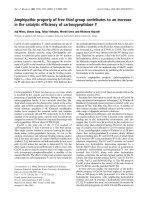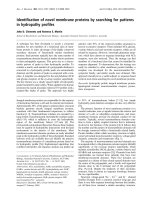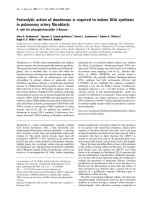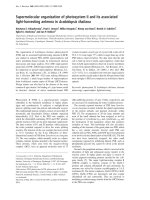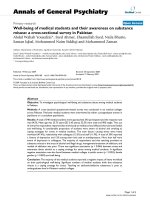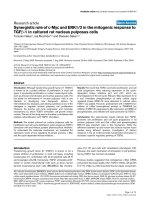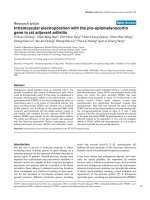Báo cáo y học: "Inter-rater reliability of the Full Outline of UnResponsiveness score and the Glasgow Coma Scale in critically ill patients: a prospective observational study" ppt
Bạn đang xem bản rút gọn của tài liệu. Xem và tải ngay bản đầy đủ của tài liệu tại đây (499.06 KB, 9 trang )
Fischer et al. Critical Care 2010, 14:R64
/>Open Access
RESEARCH
BioMed Central
© 2010 Fischer et al.; licensee BioMed Central Ltd. This is an open access article distributed under the terms of the Creative Commons
Attribution License ( which permits unrestricted use, distribution, and reproduction in
any medium, provided the original work is properly cited.
Research
Inter-rater reliability of the Full Outline of
UnResponsiveness score and the Glasgow Coma
Scale in critically ill patients: a prospective
observational study
Michael Fischer
1
, Stephan Rüegg
2
, Adam Czaplinski
2
, Monika Strohmeier
1
, Angelika Lehmann
1
, Franziska Tschan
3
,
Patrick R Hunziker
1
and Stephan C Marsch*
1
Abstract
Introduction: The Glasgow Coma Scale (GCS) is the most widely used scoring system for comatose patients in
intensive care. Limitations of the GCS include the impossibility to assess the verbal score in intubated or aphasic
patients, and an inconsistent inter-rater reliability. The FOUR (Full Outline of UnResponsiveness) score, a new coma
scale not reliant on verbal response, was recently proposed. The aim of the present study was to compare the inter-
rater reliability of the GCS and the FOUR score among unselected patients in general critical care. A further aim was to
compare the inter-rater reliability of neurologists with that of intensive care unit (ICU) staff.
Methods: In this prospective observational study, scoring of GCS and FOUR score was performed by neurologists and
ICU staff on 267 consecutive patients admitted to intensive care.
Results: In a total of 437 pair wise ratings the exact inter-rater agreement for the GCS was 71%, and for the FOUR score
82% (P = 0.0016); the inter-rater agreement within a range of ± 1 score point for the GCS was 90%, and for the FOUR
score 92% (P = ns.). The exact inter-rater agreement among neurologists was superior to that among ICU staff for the
FOUR score (87% vs. 79%, P = 0.04) but not for the GCS (73% vs. 73%). Neurologists and ICU staff did not significantly
differ in the inter-rater agreement within a range of ± 1 score point for both GCS (88% vs. 93%) and the FOUR score
(91% vs. 88%).
Conclusions: The FOUR score performed better than the GCS for exact inter-rater agreement, but not for the clinically
more relevant agreement within the range of ± 1 score point. Though neurologists outperformed ICU staff with regard
to exact inter-rater agreement, the inter-rater agreement of ICU staff within the clinically more relevant range of ± 1
score point equalled that of the neurologists. The small advantage in inter-rater reliability of the FOUR score is most
likely insufficient to replace the GCS, a score with a long tradition in intensive care.
Introduction
The assessment of comatose patients is an important part
of critical care. Unfortunately, there is no objective mea-
sure of coma like temperature or blood pressure. Thus, so
far the assessment of the level of coma has to rely on clin-
ical scores. The Glasgow Coma Scale (GCS), originally
designed for patients with head trauma [1], has become
the most widely used scoring system for patients with an
altered level of consciousness in the ICU. Important limi-
tations of the GCS include inconsistent inter-observer
reliability [2], concerns over the predictive value in brain
injury patients undergoing modern neuro-intensive care
[3], the impossibility of assessing the verbal score in intu-
bated patients, and the exclusion of brainstem reflexes.
Over the past decades, a variety of alternative scoring sys-
tems have been developed [4-7], although none of them
reached widespread acceptance.
* Correspondence:
1
Department of Medical Intensive Care, University Hospital, Spitalstrasse, Basel,
4031, Switzerland
Full list of author information is available at the end of the article
Fischer et al. Critical Care 2010, 14:R64
/>Page 2 of 9
The FOUR (Full Outline of UnResponsiveness) score, a
coma scale consisting of four components (eye response,
motor response, brainstem reflexes, and respiration pat-
tern) was recently proposed by investigators from the
Mayo Clinic [8]. Validation among patients receiving no
sedative agents by dedicated staff in neuro-intensive care
demonstrated good to excellent inter-rater reliability
[8,9]. By contrast to the GCS, the FOUR score does not
rely on a verbal response. In the ICU, a variety of condi-
tions such as intubation, sedation, or delirium preclude a
reliable assessment of a verbal response and, therefore,
the FOUR score is an attractive tool. However, before this
new score can be recommended for routine use in the
ICU, the following limitations should be addressed: so far
the FOUR score has not been validated in critically ill
patients outside of the Mayo Clinic; so far the FOUR
score has not been validated in sedated patients; and so
far the FOUR score has only been validated by dedicated
staff in neuro-ICUs. This may have resulted in a much
higher inter-rater reliability than that achievable by ICU
staff of general ICUs.
Accordingly, the aims of the present study were: to
compare the inter-rater reliability of the GCS and the new
FOUR score among unselected patients in general medi-
cal ICU; and to compare the inter-rater reliability of neu-
rological scoring provided by staff members of general
medical ICUs with that of neurologists.
Materials and methods
The study was performed on one of the two subunits of
the medical ICU of the University Hospital of Basel, Swit-
zerland. The study was approved by the regional ethical
committee. As GCS scoring was already routinely per-
formed on our unit prior to the study and no therapeutic
decisions were based on the FOUR scoring, the ethical
committee waived the need to obtain individual informed
consent.
Ratings were performed by two board-certified staff
neurologists (S.R. and A.C.) serving as gold standard,
eight ICU nurses, and four ICU physicians. Prior to the
study, all raters received an instruction by one of the neu-
rologists including a supervised scoring of GCS and
FOUR score in two patients.
We prospectively studied the FOUR score and the GCS
in consecutive adult patients admitted to our ICU. Exclu-
sion criteria were the unavailability of both neurologists
and the patients' unwillingness to participate in the rat-
ings. Scoring was performed between 9:00 am and 10:00
am on weekdays only. Scoring occurred at the first possi-
ble occasion after admittance and each patient was
scored only once. Eligible patients were identified by the
head-nurse and colour-coded on the main board showing
all patients presently admitted. If available, raters per-
formed their ratings on the coded patients in the time
frame specified. Raters were not aware of other ratings or
the results thereof. Patients were included if at least one
of the neurologists and one member of the ICU staff were
able to perform a rating within a time interval of one
hour. In addition, 100 consecutive patients were rated by
both of the two neurologists to assess their inter-rater
agreement. Patients were included if both neurologists
were able to perform their ratings within a time interval
of one hour.
For GCS scoring, the raters used a one-sided A4-sized
form containing written instructions. In intubated
patients, the rating for the verbal domain of the GCS was
defined to be 1. For the FOUR scoring, the raters used a
one-sided A4-sized form containing both written and
visual instruction: the written instruction was a German
translation of the original instruction from the Mayo
Clinic [8]; the visual instruction was a coloured copy of
the version published in 2005 [8], adapted in size to fit the
scoring form. The definition of the FOUR score and the
GCS are displayed in Table 1.
Acute physiology and chronic health evaluation
(APACHE) II scores were obtained for the first 24 hours
after admittance to the ICU. For patients that stayed for
28 days or more in our hospital or died during their hos-
pitalisation, 28-day mortality was assessed using the in-
hospital electronic patient documentation system.
Twenty eight-day mortality of discharged patients was
assessed by contacting the physician treating the patient
at home or in another institution.
Statistics
Data were analysed using SPSS (version 15.0), a commer-
cially available statistical software. Three categories of
pair-wise ratings were analysed: 1) neurologist - neurolo-
gist, 2) ICU staff ICU staff, and, 3) neurologist ICU staff.
For each category no more than one pair-wise rating was
analysed in every patient. In case of more than one pair-
wise rating in a given category (e.g. patient was rated by
two neurologists and two members of ICU staff resulting
in four pair-wise ratings in the category neurologist ICU
staff) the rating to be analysed was randomly chosen
using computer-generated numbers. Pair-wise-weighted
kappa values were calculated for the GCS and the FOUR
score. A kappa value of 0.4 or less is considered poor, val-
ues between 0.4 and 0.6 are considered fair to moderate,
values between 0.6 and 0.8 are considered good, and val-
ues above 0.8 are considered excellent agreement [10].
Although assessment of inter-rater reliability using kappa
statistics is scientifically appropriate, this approach does
not result in measures of obvious clinical usefulness.
Rather than an exact agreement we determined that for
the dynamic environment of the ICU a precision in scor-
ing within the range of ± 1 score points for both GCS and
FOUR score would be sufficient for the majority, if not all,
Fischer et al. Critical Care 2010, 14:R64
/>Page 3 of 9
clinical decisions based on the scoring result. Thus, an
inter-rater agreement within a range of ± 1 score points
for both GCS and FOUR score was chosen as primary
outcome. Secondary outcomes were exact inter-rater
agreements and ratings of the sub-components of the two
scores. For the primary outcome, a difference of 10% or
more between the agreement rates of the neurologists
and of the ICU staff was considered to be of clinical rele-
vance. We estimated that scoring around 250 patients
would allow to detect that difference with an α of 0.05
and a power of 90. Anticipating a drop-out rate of around
20% we planned to include 300 patients. We decided to
analyse three pre-defined sub-groups for the primary
endpoint: intubated patients, sedated patients, and
patients with neurological diseases as primary admit-
tance diagnosis. As previous work reported that the
motor component of the GCS (GCS-mot) has a similar
predictive value as the total GCS [5], and the combined
eye and motor component of the FOUR score (FOUR-
EM) has a similar predictive value as the total FOUR
score [11] we separately analysed the predictive values for
mortality and agreement rates for the GCS-mot and the
FOUR-EM. Cronbach's α [12] was calculated to assess the
internal consistency of both scores. Predictive values of
the scores were assessed by calculating the area under the
curve (AUC) with 95% confidence intervals from receiver
operating characteristic (ROC) curves. Frequency tables
were analysed using Fisher's exact test. A P less than 0.05
was considered to represent statistical significance.
Results
Patients
The study took place between May 2006 and April 2007.
During the study period 992 patients were admitted to
the subunit of our ICU where the study took place. In 664
cases, patients had to be excluded because no neurologist
was available or patients were unwilling to participate.
Scoring was performed on 328 patients. Of the 328, 61
(33 female; mean age 62 ± 17 years; APACHE II 13 ± 7)
had to be excluded because no pair-wise rating occurred
within a time interval of one hour. Thus, 267 patients (85
female; mean age 63 ± 17 years; APACHE II 14 ± 8) were
included in the study resulting in 437 pair-wise ratings.
Pair-wise ratings of the two neurologists were obtained in
100 of the 267 patients (40 female; mean age 64 ± 16
years; APACHE II 15 ± 7). The admittance diagnoses of
the 267 included patients are displayed in Table 2. At the
time of scoring 60 of 267 (22.5%) patients were intubated
or had a tracheostoma and 52 of 267 (19.5%) received
sedative drugs in the eight hours preceding scoring.
GCS vs. FOUR score
Overall 437 pair-wise ratings were analysed. Cronbach's α
for the GCS (0.87) and the FOUR score (0.83) indicate a
Table 1: Definition of the FOUR score and the Glascow
Coma Score
FOUR score Glascow Coma Scale
Eye response Eye response
4 = eyelids open or opened,
tracking, or blinking to
command
4 = eyes open
spontaneously
3 = eyelids open but not
tracking
3 = eye opening to
verbal command
2 = eyelids closed but open
to loud voice
2 = eye opening to
pain
1 = eyelids closed but open
to pain
1 = no eye opening
0 = eyelids remain closed
with pain
Motor response
Motor response 6 = obeys commands
4 = thumbs-up, fist, or
peace sign
5 = localising pain
3 = localising to pain 4 = withdrawal from
pain
2 = flexion response to pain 3 = flexion response
to pain
1 = extension response to
pain
2 = extension
response to pain
0 = no response to pain or
generalised myoclonus
status
1 = no motor
response
Brainstem reflexes Verbal response
4 = pupil and corneal
reflexes present
5 = oriented
3 = one pupil wide and fixed 4 = confused
2 = pupil or corneal reflexes
absent
3 = inappropriate
words
1 = pupil and corneal
reflexes absent
2 =
incomprehensible
sounds
0 = absent pupil, corneal,
and cough reflex
1 = no verbal
response
Respiration
4 = not intubated, regular
breathing pattern
3 = not intubated, Cheyne-
Stokes breathing pattern
2 = not intubated, irregular
breathing
1 = breathes above
ventilator rate
0 = breathes at ventilator
rate or apnoea
FOUR score = Full Outline of UnResponsiveness.
Fischer et al. Critical Care 2010, 14:R64
/>Page 4 of 9
high degree of internal consistency for both scores. The
frequency distribution of the GCS and FOUR scores are
displayed in Figure 1. The agreement of the ratings in the
three categories is displayed in Figure 2. Overall, there
was a statistically significant difference (P = 0.0016) with
regard to exact agreement between the GCS score (71%)
and the FOUR score (82%) but not for the agreement
within a range of ± 1 score point (GCS 90%; FOUR 92%).
Tables 3 and 4 display the kappa values for the GCS and
FOUR score, respectively. Note that the inter-rater agree-
ment of the neurologists was significantly better than that
of the ICU staff with regard to the FOUR score (Table 4)
but not for the GCS (Table 3). No significant difference in
inter-rater agreement was found for the three compo-
nents of the GCS (Table 3). In the FOUR score, however,
the inter-rater agreement significantly differed between
the four components with the component 'respiration'
achieving the highest agreement rates and the compo-
nent 'brainstem' achieving the lowest agreement rates. In
addition, the agreement between the neurologists for the
components 'brainstem' and 'respiration' was significantly
better than that between ICU staff (Table 4). Figure 3 dis-
plays the disagreement in pair-wise ratings for both
scores. As a high proportion of scorings yielded maxi-
mum scores (Figure 1) and the agreement rates were
highest at theses scores (Figure 3) we calculated kappa
values after excluding the maximum scores (i.e. GCS 15
and FOUR score 16, respectively) and found a significant
difference between the kappas with or without excluding
the maximum scores for the GCS (kappa ± 95% confi-
dence interval, 0.61 ± 0.05 vs. 0.48 ± 0.06) and the FOUR
score (0.68 ± 0.05 vs. 0.54 ± 0.08).
Agreement between the neurologists
The two neurologists agreed exactly in 73% of the GCS
scores and in 87% of the FOUR scores (P = 0.014). An
agreement between the neurologists in the range of ± 1
point was observed for 88% of the GCS and for 91% of the
FOUR scores, respectively (P = not significant (ns)).
Cronbach's α showed a high internal consistency of the
neurologists' ratings for both the GCS (α = 0.93) and the
FOUR score (α = 0.88)
Agreement between neurologists and ICU staff
In 163 pair-wise ratings, ICU staff agreed exactly with the
neurologist in 68% of the GCS scores (P = ns vs. agree-
ment of the neurologists) and in 81% of the FOUR scores
(P = 0.011 vs. GCS; P = 0.14 vs. agreement of neurolo-
gists). An agreement between the ICU staff and the neu-
rologist in the range of ± 1 point was observed for 88% of
the GCS and for 91% of the FOUR scores, respectively (P
= ns for GCS vs. FOUR; P = ns vs. agreement of the neu-
rologists).
Agreement between ICU staff
In 174 pair-wise ratings, ICU staff agreed exactly in 73%
of the GCS scores (P = ns vs. agreement of the neurolo-
gists) and in 79% of the FOUR scores (P = 0.017 vs. GCS;
P = 0.04 vs. FOUR score agreement of the neurologists).
An agreement between ICU staff in the range of ± 1 point
was observed for 93% of the GCS and for 88% of the
FOUR scores, respectively (P = ns for GCS vs. FOUR; P =
ns vs. agreement of the neurologists). The internal con-
sistency of the ICU staffs' ratings was high for both the
GCS (α = 0.87) and the FOUR score (α = 0.83).
Predictive value for 28-day mortality
Twenty eight-day mortality was 13%. There was no signif-
icant difference in the predictive values of the GCS (AUC
of the ROC 0.78, 95% confidence interval 0.68 to 0.87),
the FOUR score (AUC of the ROC 0.79, 95% confidence
interval 0.69 to 0.89), and the APACHE II score (AUC of
the ROC 0.86, 95% confidence interval 0.80 to 0.92) for
28-day mortality (Figure 4). However, mortality was sig-
nificantly (P < 0.001) higher for patients with the three
lowest total FOUR scores of 0 to 2 (83% died), when com-
pared with patients with the lowest GCS score of 3 (45%
died).
Analysis of predefined subgroups
The exact inter-rater agreement was better for the FOUR
score than for the GCS in the three predefined subgroups
intubated patients (n = 60; 78% vs. 65%, P = 0.026),
sedated patients (n = 52; 73% vs. 62%, P = 0.095), and
patients with neurological disease as primary admittance
diagnosis (n = 86; 80% vs. 69%, P = 0.046). The exact
inter-rater agreement of the neurologist and the ICU staff
for the FOUR score was 79% vs. 68% for intubated
patients, 88% vs. 74% for sedated patients, and 91% vs.
79% for patients with neurological disease as primary
admittance diagnosis, respectively. Due to the compara-
Table 2: Primary admittance diagnoses of 267 patients
undergoing scoring of GCS and FOUR in intensive care
Reason for admission N
Neurologic disorders 86
Cardiac disorders 74
Pulmonary disorders 33
Infectious diseases 33
Gastrointestinal disorders 15
Metabolic and
endocrinologic disorders
7
Renal disease 1
Other 18
FOUR score = Full Outline of UnResponsiveness; GCS, Glasgow
Coma Scale.
Fischer et al. Critical Care 2010, 14:R64
/>Page 5 of 9
tively small absolute numbers these differences failed to
reach statistical significance. There was no significant dif-
ference with regard to inter-rater agreement with a range
of ± 1 point between the GCS and FOUR score or differ-
ent kind of rater pairs for the predefined subgroups.
The AUC of the ROC of the GCS-mot for 28-day mor-
tality was 0.75 (95% confidence interval 0.64 to 0.86) and
did not significantly differ from the total GCS or the
FOUR score. Over all 437 pair-wise ratings, the exact
agreement for the GCS-mot was 87% (P < 0.0001 vs. the
total GCS; P = 0.006 vs. FOUR score). The agreement
within a range of ± 1 score point of the GCS-mot was 95%
(P = 0.0012 vs. GCS; P = 0.0002 vs. FOUR score).
The AUC of the ROC of the combined FOUR-EM for
28-day mortality was 0.76 (95% confidence interval 0.66
to 0.87) and did not significantly differ from the total
FOUR score, the GCS, or GCS-mot. Overall, 437 pair-
wise ratings, the exact agreement for the FOUR-EM was
85% (P = 0.07 vs. total FOUR score; P < 0.0001 vs. GCS).
The agreement within a range of ± 1 score point of the
FOUR-EM was 92% (P = 0.095 vs. total FOUR score; P =
0.21 vs. GCS).
Discussion
The present study compared the inter-rater agreement of
GCS and FOUR score as well as the inter-rater agreement
of neurologist and ICU staff in unselected critically ill
patients. In the primary outcome, i.e. the inter-rater
agreement within the range of ± 1 score point, there was
neither a significant difference between the GCS and the
FOUR score nor a difference between neurologists and
ICU staff. Exact inter-rater agreement was significantly
better between neurologists than between ICU staff.
Moreover, exact inter-rater agreement was significantly
better for the FOUR score than for the GCS.
Recently, Wijdicks and colleagues, Wolf and colleagues,
and Iyer and colleagues from the Mayo Clinic devised and
validated the FOUR score [8,9,13]. Compared with the
GCS, this new coma scale does not depend on a verbal
response and provides greater neurological detail by
inclusion of brainstem reflexes and breathing patterns.
The present study is the first validation of the FOUR
score in the ICU outside the institution that developed
the FOUR score. In addition, the present study is the first
validation of the FOUR score in unselected patients in a
medical ICU. In agreement with the initial reports we
Table 3: Weighted kappa values for the interrater agreement for the GCS
Rater pair n Total GCS Eye
response
Motor response Verbal response
Neurologist-
Neurologist
100 0.67 ± 0.10 0.75 ± 0.12 0.79 ± 0.10 0.78 ± 0.10
Neurologist-ICU
staff
393 0.56 ± 0.09 0.68 ± 0.10 0.68 ± 0.10 0.70 ± 0.09
ICU staff- ICU staff 321 0.63 ± 0.08 0.74 ± 0.09 0.78 ± 0.09 0.86 ± 0.07
Overall 437 0.61 ± 0.05 0.72 ± 0.06 0.74 ± 0.06 0.78 ± 0.05
Data = weighted kappa ± 95% confidence interval. No statistically significant differences exist between rater pairs or the different
components of the GCS.
GCS, Glasgow Coma Scale.
Table 4: Weighted kappa values for the interrater agreement for the FOUR score
Rater Pair n Total Eye response Motor
response
Brainstem
reflexes
Respiration
Neurologist-
Neurologist
100 0.80 ± 0.09 0.85 ± 0.09 0.88 ± 0.09 0.87 ± 0.12 1.0 ± 0.00
†
Neurologist-
ICU staff
393 0.66 ± 0.09 0.77 ± 0.09 0.73 ± 0.09 0.71 ± 0.18 0.87 ± 0.08
ICU staff- ICU
staff
321 0.63 ± 0.08* 0.85 ± 0.07 0.77 ± 0.09 0.53 ± 0.16*
†
0.87 ± 0.08*
Overall 437 0.68 ± 0.05* 0.82 ± 0.05 0.78 ± 0.05 0.67 ± 0.10 0.90 ± 0.04
Data = weighted kappa ± 95% confidence interval. * P < 0.05 vs. neurologist-neurologist at same component of the score; † P < 0.05 vs. all
other components of the FOUR score with the same raters.
FOUR score = Full Outline of UnResponsiveness.
Fischer et al. Critical Care 2010, 14:R64
/>Page 6 of 9
observed that the inter-rater reliability for the FOUR
score is at least as good as that of the GCS [8,9,13]. More-
over, our results demonstrate that the FOUR score is
superior to the GCS with regard to exact inter-rater
agreement. The inter-rater agreement in the present
study was considerably lower for both GCS (kappa 0.59
vs. 0.82 to 0.98) and FOUR score (kappa 0.63 vs. 0.82 to
0.99) than previously reported [8,9,13]. This may be
explained by the higher number of patients included in
the present study, the inclusion of intubated and sedated
patients, inherent variations in the level of consciousness
among unselected ICU patients, organisational aspects of
the scoring, and differences in the neurological expertise
of the raters. Indeed, our neurologists achieved an inter-
rater agreement for the FOUR score (kappa 0.80), but not
for the GCS (kappa 0.67), comparable with that reported
by Wijdicks and colleagues, Wolf and colleagues, and Iyer
and colleagues [8,9,13]. Previous work demonstrated that
the FOUR score predicts mortality as well as the GCS
[8,9,11,13]. This is confirmed by our finding that the pre-
dictive value for 28-day mortality of the FOUR score
equalled that of the GCS, and the APACHE II score.
Moreover, in agreement with previous work our results
demonstrate that mortality in medical ICU patients with
the lowest FOUR score is higher than in patients with the
lowest GCS.
The inter-rater agreement of the neurologists was
never worse and partly significantly better than that of
the ICU staff. However, as far as precision in scoring
within the range of ± 1 score points is concerned, ICU
staff equalled neurologists. This finding indicates that the
precision in neurological scoring sufficient for the clinical
settings achieved by general ICU staff cannot be signifi-
cantly improved by dedicated specialists from outside the
ICU.
The repetitive assessment of the level of consciousness
is a routine procedure in ICU and so far the GCS is the
most widely used tool. The present study confirms previ-
ous reports on a less than perfect inter-observer agree-
ment of the GCS [2,14,15]. For the new FOUR score, the
inter-rater agreement was never worse and partly better
than that of the GCS. As the GCS is routinely performed
in our unit, we were surprised and disappointed by the
comparatively low inter-rater agreement of a longstand-
ing standard procedure. To the best of our knowledge,
there are no systematic data on the consistency of indi-
vidual raters in repetitive ratings such as GCS in the ICU.
Such a study would be very difficult to perform because
within the time frame the level of consciousness could be
kept reliably stable in critically ill patients most health-
care workers would not forget their previous scoring
result. It is doubtful, however, that repetitive ratings are
generally more precise than the pair-wise ratings
reported in the present study. Thus, our findings suggest
that in the clinical setting scores of individual patients
should be cautiously interpreted taking into account both
the dynamic course of critical illness and inter-rater and
intra-rater disagreements.
Despite its limitations, the GCS has remained the stan-
dard coma scale over the past decades. In modern ICUs,
multiple scores are repetitively used. Ideally, these scores
should be simple, reliable, and predictive for relevant out-
comes and/or relevant clinical decisions. With regard to
these criteria, the present study revealed that the FOUR
score is at least equivalent and partly even superior to the
GCS. Given that the inter-rater reliability of the FOUR
score between the neurologists was better than that
between ICU staff and that the inter-rater reliability for
the brainstem component of the FOUR score was signifi-
cantly lower than for the other three components there is
a potential for improvement for the inter-rater reliability
of the FOUR score in the settings of the ICU. By contrast,
our data reveal no such potential for improvement for the
Figure 1 Frequency distribution of GCS and FOUR scores. Fre-
quency distribution of 814 rated Glasgow Coma Scale (GCS) scores
(top panel) and 814 rated Full Outline of UnResponsiveness (FOUR)
scores (bottom panel).
3456789101112131415
0
50
100
150
200
250
300
n
GCS
012345678910111213141516
0
50
100
150
200
250
300
n
FOUR Score
Fischer et al. Critical Care 2010, 14:R64
/>Page 7 of 9
GCS. Compared with the GCS, the FOUR score contains
more items. In addition, the brainstem categories of the
FOUR score rely on up to three different items (pupil,
corneal, and cough reflex) whereas all categories of the
GCS rely on one item only. Thus, the FOUR score
requires more time than the GCS and is more difficult to
remember in acute situations. Although the FOUR score
provides more neurological detail than the GCS it cannot
replace a more in-depth neurological evaluation. Balanc-
ing the advantages and disadvantages of both scores, it is
fair to state that the new FOUR score is a suitable alterna-
tive to the GCS. However, we think it is unlikely that the
small advantage in inter-rater reliability will prompt
intensivists to replace the GCS, a score with a long tradi-
tion in the ICU, by the new FOUR score.
Eken and colleagues reported, that in patients present-
ing with an altered level of consciousness, head trauma,
or any neurological complaints on an emergency depart-
ment, the FOUR-EM had a similar predictive value for
unfavourable outcomes as the total FOUR score and the
GCS [11]. Their finding is in agreement with the work of
Gill and colleagues showing that the three individual GCS
components alone performed similar to the total GCS
score for the prediction of 4 clinically relevant TBI out-
comes [5]. The present study confirms and extends these
previous findings by demonstrating that among unse-
Figure 2 Inter-rater agreement of GCS and FOUR scores. Scatterplots of the pair-wise ratings of neurologists (top panels), ICU staff (middle panels),
and neurologist-ICU staff (bottom panels) for the Glasgow Coma Scale (GCS; left side panels) and Full Outline of UnResponsiveness (FOUR) score (right
side panels).
GCS
3
4
5
6
7
8
9
10
11
12
13
14
15
3
4
5
6
7
8
9
10
11
12
13
14
15
GCS Neurologist 1
GCS Neurologist 2
FOUR Score
0
1
2
3
4
5
6
7
8
9
10
11
12
13
14
15
16
0
1
2
3
4
5
6
7
8
9
10
11
12
13
14
15
16
FOUR Neurologist 1
FOUR Neurologist 2
3
4
5
6
7
8
9
10
11
12
13
14
15
3
4
5
6
7
8
9
10
11
12
13
14
15
GCS ICU Staff 1
GCS ICU staff 2
0
1
2
3
4
5
6
7
8
9
10
11
12
13
14
15
16
0
1
2
3
4
5
6
7
8
9
10
11
12
13
14
15
16
FOUR ICU staff 1
FOUR ICU staff 2
Fischer et al. Critical Care 2010, 14:R64
/>Page 8 of 9
lected critically ill patients in the medical ICU the predic-
tive values of the FOUR-EM and of the motor component
of the GCS for 28-day mortality does not differ from the
total FOUR score or the GCS. Moreover, the inter-rater
agreements for the FOUR-EM and the GCS-mot in the
present study were better than for the total FOUR score
and the GCS. Thus, reducing the complexity of a score
can substantially improve inter-rater reliability without
necessarily losing predictive power. In a multivariable
analysis in over 8,000 head trauma patients Murray and
colleagues [16] found that in addition to the GCS-mot,
pupil reaction has an independent predictive value.
Therefore, we tested whether adding the information on
bilateral pupil reactivity to the FOUR-EM would signifi-
cantly increase the predictive value for 28-day mortality,
which was not the case.
A limitation of our study is that due to the inclusion of
unselected, and especially sedated, patients and the maxi-
mum time interval allowed for pair-wise ratings of one
hour no perfectly stable experimental conditions for scor-
ing were achieved. Particularly, we cannot exclude that
some inter-rater disagreements are caused by true altera-
tions in the level of consciousness. However, as raters
performed the GCS and the FOUR score simultaneously
such true alterations in the level of consciousness cannot
explain the observed differences in the inter-rater agree-
ment between the two scores. Moreover, our study condi-
tions reflect the dynamic environment in the ICU so that
our results give a fair estimate of the reliability of two
coma scales in daily practice. A further limitation of our
study is that no surgical patients, and especially no head
trauma cases, were included so that the findings relate to
unselected medical critically ill patients only. An inherent
limitation of the validation of coma scales is the absence
of an objective measure of the level of coma. Thus it
should be kept in mind that better inter-rater reliability
does not necessarily mean better accuracy.
Figure 3 Disagreement rates for GCS and FOUR scores. Disagree-
ments of more than one score point in pair-wise ratings of the Glasgow
Coma Scale (GCS) score (top panel) and the Full Outline of UnRespon-
siveness (FOUR) score (bottom panel) respectively. Scores are divided
into quartiles. As a substantial proportion of ratings were at the maxi-
mum of the each scale (i.e. GCS 15, FOUR 16), the maximum category
is shown separately in addition to the quartiles. Disagreements are ex-
pressed as a percentage of the total number of ratings in a given
quartile of the GCS score and FOUR score, respectively. White bars =
disagreements between the neurologists; black bars = disagreements
between the neurologists and ICU staff; grey bars = disagreements be-
tween ICU staff. For both scores, disagreements were significantly (P <
0.001) less frequent in the maximum category (i.e. GCS 15, FOUR 16)
than in all other categories. * For the lowest quartile of the FOUR score,
the disagreement between neurologist and ICU staff (P = 0.034) and
between ICU staff and ICU staff (P = 0.045) was significantly greater
than that between the neurologists.
3-5 6-8 9-11 12-14 15
0
25
50
75
100
Neurologist vs Neurologist
Neurologist vs ICU staff
ICU staff vs ICU staff
GCS Score
% Disagreement
0-3 4-7 8-11 12-15 16
0
25
50
75
100
FOUR Score
% Disagreement
Figure 4 Predictive value for 28-day mortality. Receiver operating
characteristic curve for the predictive value of Glasgow Coma Scale
(GCS), Full Outline of UnResponsiveness (FOUR) score, and acute phys-
iology and chronic health evaluation (APACHE) II score on 28-day mor-
tality. There was no statistically significant difference between the
areas under the curve of the three scores.
1 - Specificity
1.00.80.60.40.20.0
Sensitivity
1.0
0.8
0.6
0.4
0.2
0.0
APACHE II
FOUR score
GCS
Fischer et al. Critical Care 2010, 14:R64
/>Page 9 of 9
Conclusions
The FOUR score performs better than the GCS with
regard to exact inter-rater agreement, but not for the clin-
ically more relevant agreement within the range of ± 1
score point or the predictive value for 28-day mortality.
Although neurologists outperform ICU staff with regard
to exact inter-rater agreement, the inter-rater agreement
of ICU staff within the clinically more relevant range of ±
1 score point equals that of the neurologists. Thus, a pre-
cision in neurological scoring sufficient for the clinical
settings cannot only be achieved by dedicated staff in
specialised neuro-ICUs but also by ICU staff in general
ICUs. The small advantage in inter-rater reliability of the
FOUR score is most likely insufficient to replace the GCS,
a score with a long tradition in the ICU.
Key messages
• The FOUR score, a new coma scale not relying on
verbal response, performs better as the GCS with
regard to exact inter-rater agreement, but not for the
clinically more relevant agreement within the range of
± 1 score point.
• In neurological scoring, the inter-rater agreement
within the range relevant for clinical decisions of ICU
staff equals that of neurologists.
Abbreviations
APACHE: acute physiology and chronic health evaluation; AUC: area under the
curve; FOUR: Full Outline of UnResponsiveness; FOUR-EM: combined eye and
motor component of the FOUR score; GCS: Glascow Coma Scale; GCS-mot:
motor component of the GCS; ROC: receiver operator characteristics.
Competing interests
The authors declare that they have no competing interests.
Authors' contributions
MF participated in the design of the study, performed the neurological scoring,
and was responsible for data management. SR participated in the design of the
study and performed the neurological scoring. AC performed the neurological
scoring. MS was responsible for identifying suitable patients and performed
the neurological scoring. AL participated in the design of the study and per-
formed the neurological scoring. FT participated in the design of the study and
performed the statistical analysis. PH participated in the design of the study
and performed the neurological scoring. SM participated in the design of the
study, performed the neurological scoring, and drafted the manuscript. All
authors contributed to the interpretation of the results and read and approved
the final manuscript.
Author Details
1
Department of Medical Intensive Care, University Hospital, Spitalstrasse, Basel,
4031, Switzerland,
2
Department of Neurology, University Hospital, Spitalstrasse,
Basel, 4031, Switzerland and
3
Department of Psychology, University of
Neuchatel, Rue de la Maladière, Neuchatel, 2000, Switzerland
References
1. Teasdale G, Jennett B: Assessment of coma and impaired consciousness.
A practical scale. Lancet 1974, 2:81-84.
2. Gill M, Martens K, Lynch EL, Salih A, Green SM: Interrater reliability of 3
simplified neurologic scales applied to adults presenting to the
emergency department with altered levels of consciousness. Ann
Emerg Med 2007, 49:403-407.
3. Balestreri M, Czosnyka M, Chatfield DA, Steiner LA, Schmidt EA, Smielewski
P, Matta B, Pickard JD: Predictive value of Glasgow Coma Scale after
brain trauma: change in trend over the past ten years. J Neurol
Neurosurg Psychiatry 2004, 75:161-162.
4. Benzer A, Mitterschiffthaler G, Marosi M, Luef G, Puhringer F, De La
Renotiere K, Lehner H, Schmutzhard E: Prediction of non-survival after
trauma: Innsbruck Coma Scale. Lancet 1991, 338:977-978.
5. Gill M, Windemuth R, Steele R, Green SM: A comparison of the Glasgow
Coma Scale score to simplified alternative scores for the prediction of
traumatic brain injury outcomes. Ann Emerg Med 2005, 45:37-42.
6. Stanczak DE, White JG III, Gouview WD, Moehle KA, Daniel M, Novack T,
Long CJ: Assessment of level of consciousness following severe
neurological insult. A comparison of the psychometric qualities of the
Glasgow Coma Scale and the Comprehensive Level of Consciousness
Scale. J Neurosurg 1984, 60:955-960.
7. Starmark JE, Stalhammar D, Holmgren E, Rosander B: A comparison of the
Glasgow Coma Scale and the Reaction Level Scale (RLS85). J Neurosurg
1988, 69:699-706.
8. Wijdicks EF, Bamlet WR, Maramattom BV, Manno EM, McClelland RL:
Validation of a new coma scale: The FOUR score. Ann Neurol 2005,
58:585-593.
9. Wolf CA, Wijdicks EF, Bamlet WR, McClelland RL: Further Validation of the
FOUR score coma scale by intensive care nurses. Mayo Clinic
Proceedings 2007, 82:435-438.
10. Landis JR, Koch GG: The measurement of observer agreement for
categorical data. Biometrics 1977, 33:159-174.
11. Eken C, Kartal M, Bacanli A, Eray O: Comparison of the Full Outline of
Unresponsiveness Score Coma Scale and the Glasgow Coma Scale in
an emergency setting population. Eur J Emerg Med 2009, 16:29-36.
12. Bland JM, Altman DG: Cronbach's alpha. BMJ 1997, 314:572.
13. Iyer VN, Mandrekar JN, Danielson RD, Zubkov AY, Elmer JL, Wijdicks EF:
Validity of the FOUR score coma scale in the medical intensive care
unit. Mayo Clin Proc 2009, 84:694-701.
14. Ely EW, Truman B, Shintani A, Thomason JW, Wheeler AP, Gordon S,
Francis J, Speroff T, Gautam S, Margolin R, Sessler CN, Dittus RS, Bernard
GR: Monitoring sedation status over time in ICU patients: reliability and
validity of the Richmond Agitation-Sedation Scale (RASS). JAMA 2003,
289:2983-2991.
15. Kho ME, McDonald E, Stratford PW, Cook DJ: Interrater reliability of
APACHE II scores for medical-surgical intensive care patients: a
prospective blinded study. Am J Crit Care 2007, 16:378-383.
16. Murray GD, Butcher I, McHugh GS, Lu J, Mushkudiani NA, Maas AI,
Marmarou A, Steyerberg EW: Multivariable prognostic analysis in
traumatic brain injury: results from the IMPACT study. J Neurotrauma
2007, 24:329-337.
doi: 10.1186/cc8963
Cite this article as: Fischer et al., Inter-rater reliability of the Full Outline of
UnResponsiveness score and the Glasgow Coma Scale in critically ill patients:
a prospective observational study Critical Care 2010, 14:R64
Received: 25 November 2009 Revised: 4 February 2010
Accepted: 14 April 2010 Published: 14 April 2010
This article is available from: 2010 Fisc her et al.; licens ee BioMed Central Ltd. This is an open access article distributed under the terms of the Creative Commons Attribution License ( which permits unrestricted use, distribution, and reproduction in any medium, provided the original work is properly cited.Critica l Care 2010, 14:R 64

